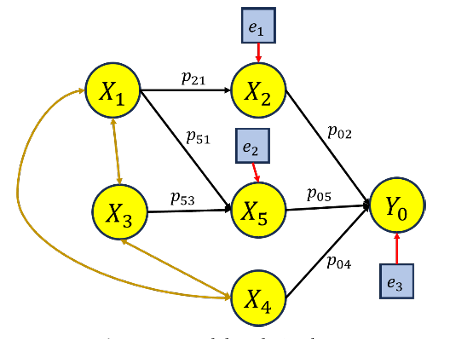Analysis of the Relationship Between Library Services and Education Factors on the Community Literacy Development Index Using Path Analysis
Main Article Content
Abstract
The application of Path Analysis for causal modelling is widely used in various fields of study, one of which is education. Path Analysis is applied to test the relationship model between variables: CLDI (Community Literacy Development Index) (Y0), library service equity (X1), library collection adequacy (X2), library staff adequacy ratio (X3), community visit rate per day (X4), and education completion rate (X5). In addition, the adequacy of the library collection (X2), the level of community visits (X4), and the level of education completion (X5) significantly affect the CLDI (Y0). The combination of library and education service variables explained 70.19 per cent of the variation in CLDI. This study concludes the importance of synergy between libraries and education in improving community literacy and recommends strengthening literacy programmes based on library services and quality education.
Article Details
References
[1] K. Dalman. Keterampilan Membaca. Rajawali Pers, Jakarta, 2014.
[2] I. W. Antasari. Implementasi gerakan literasi sekolah tahap pembiasaan di mi muhammadiyah gandatapa sumbang banyumas. Libria, 9(1):13–26, 2017.
[3] S. Wahyuni. Menumbuhkembangkan minat baca menuju masyarakat literat. Diksi, 16(2):179–189, 2009.
[4] S. Kusmana. Pengembangan budaya literasi dalam pembelajaran bahasa indonesia. In Seminar Nasional Pendidikan Bahasa Indonesia, volume 1, pages 1–11, 2017.
[5] S. Arikunto. Prosedur Penelitian: Suatu Pendekatan Praktik. Rineka Cipta, Jakarta, 2016.
[6] S. Wright. Correlation and causation. Journal of Agricultural Research, 20:557–585, 1921.
[7] S. Wright. The method of path coefficients. Annals of Mathematical Statistics, 5:161–215, 1934.
[8] G. P. Vogler. Multivariate path analysis of familia resemblance. Genetic Epidemiology, 2:35–53, 1985.
[9] E. R. Warsono, Wamiliana, M. Usman, Widiarti, and F. A. M. Elfaki. Causal modeling of the effect of foreign direct investment, industry growth and energy use to carbon dioxide emissions. International Journal of Energy Economics and Policy, 10(3):348–354, 2020.
[10] H. B. Asher. Causal Modeling. Sage Publications, Newbury Park, California, 2 edition, 1983.
[11] L. T. Bryant. A path analysis model for secondary physicsm enrollments. Journal of ResearchinScience Teaching, 14:177 189, 1977.
[12] J. S. Stanley and R. L. Doran. Replication of a path analysis model of secondary physics enrollments: 20 years later. Journal of Research in Science Teaching, 33(5):501–512, 1996.
[13] A. J. Berinsky and G. S. Lenz. Education and political participation: Exploring the causal link. Political Behavior, 33:357–373, 2011.
[14] H. R. Alker. Statistics and politics: The need for causal data analysis. In S. M. Lipset, editor, Politics and The Social Sciences, pages 244–313. Oxford University Press, New York, 1969.
[15] H. M. Blalock. Causal Models In The Social Sciences. Aldine Atherton, Chicago, 1971.
[16] D. F. Alwin and R. M. Hauser. The decomposition of effects in path analysis. American Sociological Review, 40:37–47,1975.
[17] R. A. Berk. Causal inference for sociological data. In N. J. Smelser, editor, Handbook of Sociology, pages 155–172. Sage, Newbury Park, 1988.
[18] S. L. Morgan and C. Winship. Counterfactuals and Causal Inference: Methods and Principles For Social Research. Cambridge University Press, New York, 2 edition, 2015.
[19] R. P. Bagozzi. Causal Models in Marketing. John Wiley, New York, 1980.
[20] J. Pearl, M. Glymour, and N. P. Jewell. Causal Inference in Statistics: A Primer. Wiley, 1 edition, 2016.
[21] A. Gammerman. Causal Models and Intelligent Data Management. Springer-Verlag, Berlin Heidelberg, 1999.
[22] E. J. Pedhazur. Multiple Regression In Behavioral Research: Explanation And Prediction. Wadsworth Publishing, California, 3 edition, 1997

